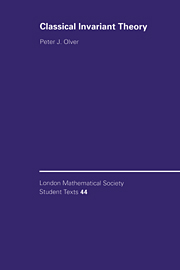Book contents
- Frontmatter
- Contents
- Introduction
- 1 Prelude — Quadratic Polynomials and Quadratic Forms
- 2 Basic Invariant Theory for Binary Forms
- 3 Groups and Transformations
- 4 Representations and Invariants
- 5 Transvectants
- 6 Symbolic Methods
- 7 Graphical Methods
- 8 Lie Groups and Moving Frames
- 9 Infinitesimal Methods
- 10 Multivariate Polynomials
- References
- Author Index
- Subiect Index
Introduction
Published online by Cambridge University Press: 08 January 2010
- Frontmatter
- Contents
- Introduction
- 1 Prelude — Quadratic Polynomials and Quadratic Forms
- 2 Basic Invariant Theory for Binary Forms
- 3 Groups and Transformations
- 4 Representations and Invariants
- 5 Transvectants
- 6 Symbolic Methods
- 7 Graphical Methods
- 8 Lie Groups and Moving Frames
- 9 Infinitesimal Methods
- 10 Multivariate Polynomials
- References
- Author Index
- Subiect Index
Summary
Classical invariant theory is the study of the intrinsic or geometrical properties of polynomials. This fascinating and fertile field was brought to life at the beginning of the last century just as the theory of solubility of polynomials was reaching its historical climax. It attained its zenith during the heyday of nineteenth-century mathematics, uniting researchers from many countries in a common purpose, and filling the pages of the foremost mathematical journals of the time. The dramatic and unexpected solution to its most fundamental problem — the finitude of the number of fundamental invariants — propelled the young David Hilbert into the position of the most renowned mathematician of his time. Following a subsequent decline, as more fashionable subjects appeared on the scene, invariant theory sank into obscurity during the middle part of this century, as the abstract approach entirely displaced the computational in pure mathematics. Ironically, though, its indirect influence continued to be felt in group theory and representation theory, while in abstract algebra the three most famous of Hilbert's general theorems — the Basis Theorem, the Syzygy Theorem, and the Nullstellensatz — were all born as lemmas (Hilfsätze) for proving “more important” results in invariant theory! Recent years have witnessed a dramatic resurgence of this venerable subject, with dramatic new applications, ranging from topology and geometry, to physics, continuum mechanics, and computer vision. This has served to motivate the dusting off of the old computational texts, while the rise of computer algebra systems has brought previously infeasible computations within our grasp.
- Type
- Chapter
- Information
- Classical Invariant Theory , pp. x - xxiiPublisher: Cambridge University PressPrint publication year: 1999



